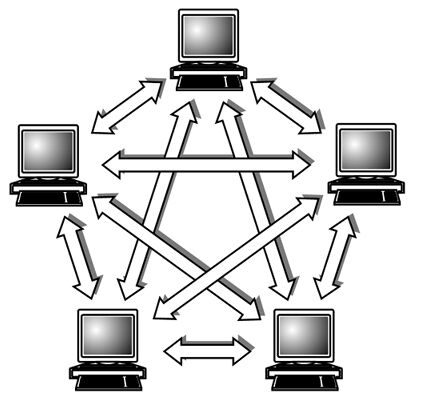Overview
On a peer-to-peer network, every computer is equal and can communicate with any other computer on the network to which it has been granted access rights. Essentially, every computer on a peer-to-peer network can function as both a server and a client; any computer on a peer-to-peer network is considered a server if it shares a printer, a folder, a drive, or some other resource with the rest of the network. This is why you might hear about a computer being referred to as a server, even when the discussion is about a peer-to-peer network. Peer-to-peer networks can be as small as two computers or as large as hundreds of computers. Although there is no theoretical limit to the size of a peer-to-peer network, performance drops significantly and security a larger concern on peer-based networks with more than 10 computers.

Advantages
| • | Allows two or more PCs to pool their resources together. |
| • | Can be built with both 10BaseT cabling and a hub or with a thin coax backbone. |
| • | Drives can be easily shared between peer-to-peer PCs. |
| • | Reduced cost (the costs involved in such a network are hardware, cabling and maintenance. |
| • | Setup - An operating system (such as Windows XP) already in place may only need to be reconfigured for peer-to-peer operations. |
| • | Less initial expense - No need for a dedicated server. |
| • | Peer-to-peer is, by far the easiest type of network to build for either home or office use. |
| • | Each computer can make backup copies of its data to other computers for security. |
| • | Network is relatively fast and inexpensive to setup and maintain. |
Disadvantages
| • | Lack of security - They are less secure than client-server networks, especially so because the files have to shared and no password is required. |
| • | No computer in the network is reliable |
| • | This system is not centralized, making administration difficult. |
| • | It is more time consuming to maintain the software on individual computers |
| • | Peer-to-peer networks are designed for a small number of users. Network speed and performance starts to deteriorate usually after more than 10 computers are on the network. This makes it difficult to grow the network when the need to add more computers on the network becomes unavoidable. |
| • | Possibility of not discovering all peers |
Installation
None. Your computers running Windows 2000, Vista and XP already have Peer-to-Peer Networking installed.
If not, then for computers running Windows XP with Service Pack 2, do the following to install Windows Peer-to-Peer Networking:
| 1) | Click Start, click Control Panel, and then click Add or Remove Programs. |
| 2) | Click Add/Remove Windows Components. |
| 3) | In Components, click Networking Services (but do not select its check box), and then click Details. |
| 4) | Select the Peer-to-Peer check box, and then click OK. |
| 5) | Click Next, and then follow the instructions in the wizard. |
NOTE: For computers running Windows XP with Service Pack 1 (SP1), you can install Windows Peer-to-Peer Networking with the Advanced Networking Pack for Windows XP.
